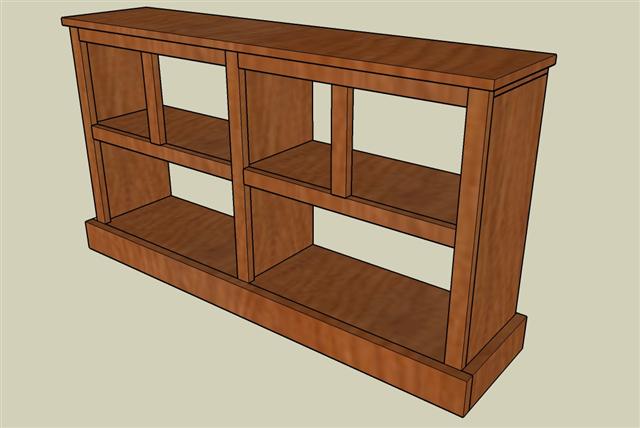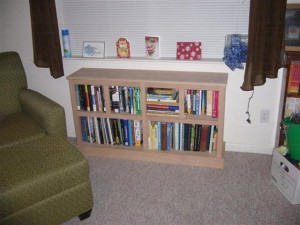This is the first part in a two part series about how to design, build, and finish a simple woodworking project. This part focuses on the design and build of the project.
Jessica and I tend to collect a lot of books. I mean a LOT of books. When one of those cheap 7ft tall particle board bookcases we had finally bit the dust, and fell on me, I decided we would only get solid wood bookcases from now on. I also decided that it was probably best that the bookcase we get to replace the broken one be rather short, something that would fit just under the window in our living room. With the cost of solid wood bookcases being pretty high and nothing available suiting our needs exactly, I decided we should design and build one ourselves. Rather than trying to fit a new bookcase into our living room, why not design one that already fits?
This project was a practice in two arts. Firstly, it was an excuse to teach myself how to use Google Sketchup, and secondly I wanted to get more experience with woodworking. Most of the earlier projects I did with wood were literally laughed at (and many with good reason), so I had plenty of room to grow.
The first step in this whole process was to design something to build. I researched a lot on the internet for the perfect bookcase style. I didn’t find anything that I could easily build with the tools I had laying around. Being in a small apartment without a garage, it is hard to store table saws and the like. The tools I have are power hand tools, a circular saw, a power sander, an electric drill, and other simple things like that.
I finally decided on what I would build. I took elements from many book cases I saw online and started drawing up my idea in Sketchup. The easiest way to do this, I’ve found, is to simply create a particular piece of wood, then make that piece a “component.” Then you can treat the whole thing as a single object. I will go into more depth about Google Sketchup and even the Sketchup physics engine in other posts, feel free to check them out.
After lots of playing around, and learning the basics of Sketchup, I ended up with this:
Everything in the design could easily be bought from any lumber yard or hardware store. It consisted of 1”x2”s, 2”x12”s, and 1”x4”s. Sadly, these measurements are the wet weight measurements, before the wood is fully dried. When dried, the wood actually shrinks a good bit. Here’s a chart that may help you find the actual sizes of dimensional lumber. I already knew this fact; however for some reason I completely ignored it when designing. So back to the drawing board I went.
I planned on making this out of Red Oak (which is a hardwood). The dimensions of hardwood lumber are a little different, but since I’m cutting by hand, the difference of 1/16th of an inch between the dimensions won’t matter. I redrew the design to account for the different wood sizes. This wasn’t very hard as I had made all the wood pieces components, and copied and pasted things that were the same size. In Sketchup, editing one of a group of the same components changes all other components automatically. For instance if I changed the height of one side, the other side will change automatically. This speeds up corrections somewhat. There is also an option to make a particular component unique, so changes made to it only apply to that particular part.
Once I had the design, I had to figure out a way of connecting the parts. Of course I would use screws and glue, but how would I connect everything together without showing the screw holes? I stumbled on a neat joinery method called “pocket screws”. Pocket screws use a jig to drill a hole diagonally through the end of one piece of wood, and into another. This can completely hide the screw while still making a very strong connection.
With all the wood dimensions I needed, I was off to the local super-hardware center. At many super-hardware centers, they offer boards by the foot. They’ll even cut it to length for you. So I looked for the straightest, cleanest Red Oak boards I could find (there weren’t many). Finally deciding on certain boards, I asked for help from one of the store associates who ran the saw. Now, anyone with common sense knows that when you use a saw blade to cut a piece of wood, you are actually removing a strip of wood the thickness of the saw blade. Apparently, this is not in the training video for this particular super-hardware store as the associate proceeded to cut my parts “through the center of the measurement mark.” Worse than that, he was inconsistent with it. Sometimes he would cut the center of the measurement mark, and sometimes he would cut it a bit short, and sometimes a bit long. All of this threw my measurements off again.
I grabbed a pocket hole jig kit and wood glue on my way out of the store after gathering all my poorly cut lumber. The approximate price breakdown is:
- Lumber = $160
- Tools and Glue = $30
It was a fairly expensive project, but completely worth it. Overall, this project still cost less than buying a brand new solid wood under-window bookcase, especially if it were custom built. Not to mention all the fun that was had and all the stuff we learned while building it.
Finally having all the parts, I knew I’d have to cut most of the boards smaller again to resize them all. I redrew the design yet again in Sketchup to make sure it would all work out. After this, Jessica and I got to work. We cut and rough-sanded all of the parts. Sanding took forever as Red Oak is a very hard wood. It was December of 2008, and we were working outside on the back deck, so instead of taking time to take loads of detailed pictures of the process and freezing to death, we hurriedly put it together exactly as the Sketchup file shows.
The Final Sketchup file can be downloaded from the Google 3d Warehouse. Feel free to edit it and repost it (as long as you give us inspiration credit ;). )
Since it was winter, we couldn’t stain the bookshelf as it was way too cold outside for the stain to set. The stain cannot be applied below 65°. Part 2 of this article goes through the process (with more pictures) and the results of staining.





I love your blog.. very nice colors & theme. Did you create this
website yourself or did you hire someone to do it for you? Plz answer back as I’m looking to design my own blog and would like to find out where u got this from. many thanks
Hi Damien,
Thank you very much. I (cough) made it myself. Okay, correction. I edited a wordpress theme that someone else made. Look up wordpress and free themes. They rock!